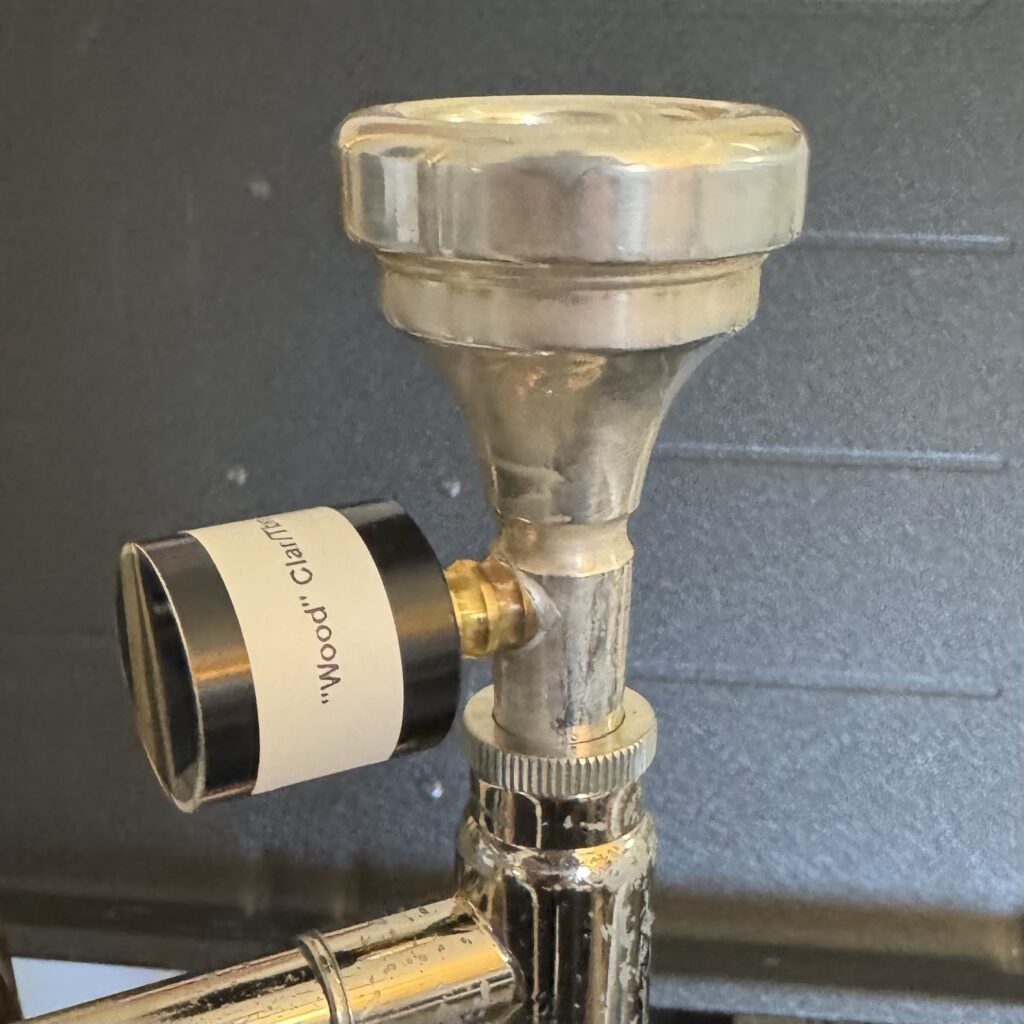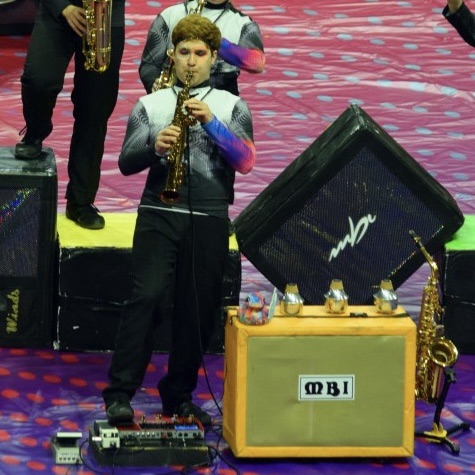We get a lot of questions about how we “AMPED!” our hornline for the 2025 MBI Winds show. Here’s an inside look at our technical journey when searching for those tones…
Pickups
This experiment started in the 2024 season at one rehearsal spot – a church that has a bunch of guitar amps. We discovered a product called PiezoBarrel and I bought one to try out. Originally designed for clarinet (hence the name), this piezoelectric pickup works by picking up sound from the inside of the instrument. For clarinet, they sell a pre-fabbed barrel that has the pickup adapter pre-installed. Sabrina, our clarinetist, provided some wild examples of what it would sound like with generated harmonies from a Boss PS-6 Harmonist pedal.
Brass
The same piezoelectric setup can be used on brass instruments. None of this is new technology. Miles Davis can be seen here in 1971 playing with a piezoelectric pickup on his trumpet mouthpiece and using a wah pedal:
For our brass soloists we purchased several PiezoBarrel setups:
- A pre-soldered Bach 3C with a P9 pickup.
- Another P9 pickup – we soldered the adapter to a Yamaha MP-14F4 mellophone mouthpiece.
- A “Wood” pickup – we soldered the adapter to a Dennis Wick LS-5 trombone mouthpiece. Dennis Wick is preferred due to the smooth shape of the shank:

Sax
For saxophone we could have used the piezo setup, but it would have required drilling and soldering into the neck. Instead we took a page out of Ryan Zoidis’s book – he plays saxophone for Lettuce:
Our setup is exactly like his: a K & K Sound Hot Spot contact pickup that goes directly on the reed with a small dab of poster putty in-between, and then electrical tape to hold it all in place.
Pedalboard
For pedal effects here’s what we used:
- $10 DIY wooden pedalboard from craigslist
- Lots of 3M Dual-Lock plus Adhesion Promoter to make it stick
- Boss LS-2 Line Selector (to switch between instruments)
- Boss FV-500L Foot Pedal (any expression pedal would do, we had this leftover from our 2024 production “Make Your Mark”)
- Valeton GP-200 Multi-Effects pedal
- Talentcell 9V battery pack plus a string of power adapters
- 2x 1/4 instrument cables (TS/Mono) – one for our sax setup, and one for the expression pedal
- 1/8″ to 1/4″ instrument cable (included with the piezoelectric pickup)
The Valeton GP-200 is at the heart of the setup and was both a cost and logistics choice. When it comes to multi-effects, it was getting a lot of great reviews:
At $300 it was going to cover all the effects we wanted (distortion, reverb, wah, EQ) that would have been $100/ea if we went with dedicated pedals. The all-in-one interface let us customize the patches so they’re tailored for each instrument.
The Amp
Before we arrived at the GP-200 solution, we had experimented with several actual guitar amplifiers. All of them were modeling amps, meaning they not only had multiple effects built in, but they had presets to mimic famous sounds.
- VOX VT-20X (seen here)
- Blackstar ID:Core
- Fender GTX-50 – a great option when used with the GTX-7 pedal
We also looked at the Boss Katana 50 which seems like a very comprehensive setup in regards to sounds and footswitch setups.
At early rehearsals we quickly discovered we’d need an EQ and a noise gate for the volumes we were shooting for. A jazz band colleague had suggested a multi-effects pedal and a PA speaker combo. We already had a battery powered Bose S1 speaker (also from “Make Your Mark”) that we could plug directly into. With a simple 9V battery pack for the pedals, there was no external power needed and we could stage the “Amp” anywhere. That made it the preferred solution – we just needed a way to make it look believable.
A volunteer constructed an amp-sized box to house the speaker and then we stylized it to look like an “Orange” brand amplifier. One judge even commented how we should look at our EQ settings because Orange amps have a particular sound. I was flattered and informed him it’s just made to look like an Orange amp, and that we’ll continue to refine our EQing 😎



